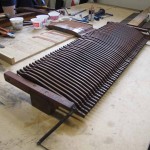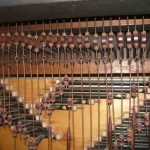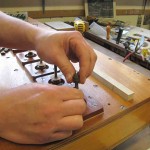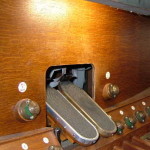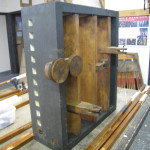| | SCALE: The proportion of the diameter to the length of a pipe. This governs the tone quality: e.g. Flue pipes of large scale give a broad, fluty sound, whereas small-scale pipes give a thinner sound. |
 | SHALLOT: The brass tube located in the boot of a Reed pipe, against which the tongue vibrates to produce a sound. |
 | SLIDER: A strip of wood or other material with holes that align with the pipe feet of a particular Stop on a Slider chest. The slider moves to stop the wind from entering the pipes located above it and prevent them from sounding. It is actuated by a Stop knob or Drawstop at the console. See also Stop. |
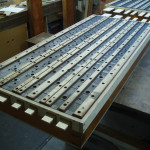 | SLIDER CHEST, or Slider soundboard: A type of Windchest, the oldest in common use, valued for its musical benefits. It consists of a wooden grid with a wind channel for each note, and valves or Pallets to admit the wind to the pipes; the Stops being controlled by Sliders with holes corresponding to the pipe feet. Much skill is required in the design and construction of a slider chest. |
 | SOLO ORGAN: The fourth Division of an English four-manual organ, played from the top keyboard.
. |
 | SOUNDBOARD: an alternative term for Windchest. |
 | SQUARE: An L-shaped component in a Tracker action, pivoted between its two arms, which turns the motion through 90o degrees. A set of squares is mounted on a ‘square beam’. |
| | STICKER: A strip of wood that carries the motion of the key to the windchest by a pushing motion, in an organ that is built with Tracker action. (Distinct from a Tracker, which has a pulling motion.)
.
. |
 | STOP: 1. A set of pipes, all of similar construction, arranged on a Windchest so that there is one pipe for each note of the respective keyboard. 2. The control which admits wind to a set of pipes, or ‘stops’ wind from entering – hence the term. (See also Stop knob.) |
 | STOP ACTION or Drawstop action: See Action |
 | STOP KNOB, or Drawstop: The control at the console which the organist pulls to select a particular set of pipes. Hence the expression ‘Pulling out all the stops’. |
 | SWELL-BOX, SWELL SHUTTERS: In many organs one or more groups of pipes (e.g. Swell Organ, Solo Organ) are enclosed in a ‘swell-box’ with shutters, also known as shades or louvres, which can be opened or closed by the player to make a crescendo or diminuendo, using a Swell pedal. |
 | SWELL ORGAN: One of the main Divisions of an organ, enclosed in a Swell-box. Played from the top manual of a two- or three-manual English organ |
 | SWELL PEDAL (or expression pedal): See Swell-box. Two swell pedals can be seen at the top centre of the photo. |
| | TOE/TOE-HOLE: The toe is the lower end of the foot of a pipe. The size of the toe-hole regulates the amount of wind that can enter the pipe. |
 | TONGUE: The thin strip of brass that vibrates to produce the sound in a reed pipe. |
 | TRACKER: A thin strip of wood (or sometimes metal) that carries the motion of the key to the windchest by a pulling motion in an instrument that is built with a Tracker action. (Distinct from a Sticker, which has a pushing motion.) |
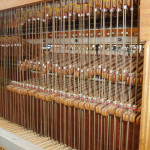 | TRACKER ACTION, also known as Mechanical action: The oldest form of Action, still used today and admired for the way in which it allows the player to control the speech of the pipes. It involves a system of rods (Trackers) and levers, whereby the player’s touch at the keyboard is transmitted directly to the valves which admit wind to the pipes. See also Electro-pneumatic action. |
 | (WIND) TRUNKS: Ducts that distribute wind to the various parts of an organ; normally made of wood or metal. See also Conveyances. |
 | TUNING: The process of finely adjusting each pipe in the organ to the correct pitch so that they all sound in tune with each other. Flue pipes are tuned by slightly lengthening or shortening the Body length to make the note flatter or sharper; Reed pipes are tuned by altering the beating length of the Tongue. The pitch of organ pipes is affected by temperature of the air in and around them; flue pipes are affected differently from reed pipes, which is one reason why organs need periodic tuning. |
 | UPPERBOARD: The top layer of a windchest upon which pipes stand. |
 | VOICING: The art of adjusting the various parts of a pipe to produce the desired musical tone. The Voicer is responsible for the musical character of each instrument, preparing the pipes in the workshop and then adjusting each one in the building so that each rank has the appropriate balance with its neighbours and all combine to form a harmonious and exciting whole.
. |
| | WIND: The pressurised air which makes the organ pipes sound. See also Bellows, Blower, Reservoir.
. |
 | WINDCHEST: The intricately-constructed box of wind upon which the pipes stand. It contains the mechanism which allows the wind to enter the pipes, depending on the notes played and the Stops selected by the organist. There are many different types – notably the Slider chest. An alternative term is Soundboard (regardless of the fact that an organ windchest is quite different in function from the soundboard of a piano or harpsichord). |
